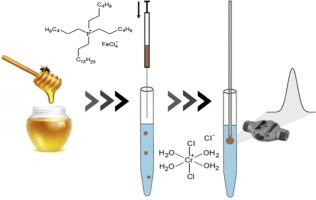当前位置:
X-MOL 学术
›
Spectrochim. Acta B. At. Spectrosc.
›
论文详情
Our official English website, www.x-mol.net, welcomes your feedback! (Note: you will need to create a separate account there.)
Ultra-trace Cr preconcentration in honey samples by magnetic ionic liquid dispersive liquid-liquid microextraction and electrothermal atomic absorption spectrometry
Spectrochimica Acta Part B: Atomic Spectroscopy ( IF 3.3 ) Pub Date : 2020-07-01 , DOI: 10.1016/j.sab.2020.105879 Emiliano F. Fiorentini , María N. Oviedo , Rodolfo G. Wuilloud
Spectrochimica Acta Part B: Atomic Spectroscopy ( IF 3.3 ) Pub Date : 2020-07-01 , DOI: 10.1016/j.sab.2020.105879 Emiliano F. Fiorentini , María N. Oviedo , Rodolfo G. Wuilloud

|
Abstract An analytical method based on the dispersive liquid-liquid microextraction (DLLME) technique, using a magnetic ionic liquid (MIL) as an extraction phase, was developed for ultra trace Cr determination in honey samples. The elemental detection was performed by electrothermal atomic absorption spectrometry (ETAAS). In the developed method both centrifugation and complexation of the analyte were not required. The Cr(III) species was extracted by the MIL trihexyl(tetradecyl)phosphonium ([P6,6,6,14]FeCl4) after the formation of [CrCl2(H2O)4]Cl. The MIL phase was separated by a magnetic rod, diluted in CHCl3 and Cr was determined by ETAAS. Under optimized experimental conditions, an extraction efficiency of 98% and a sensitivity enchancement factor of 105 were achieved. A detection limit (LOD) of 5 ng L−1 Cr and relative standard deviation of 3.5% (at 50 ng L−1 Cr and n = 10) were obtained. Also, the linear range of the calibration curve was from 15 ng L−1 to 180 ng L−1. The method was applied for Cr determination in honey samples of different shades.
中文翻译:

磁性离子液体分散液液微萃取和电热原子吸收光谱法预浓缩蜂蜜样品中的超痕量铬
摘要 建立了一种基于分散液-液微萃取(DLLME) 技术,以磁性离子液体(MIL) 为萃取相的分析方法,用于测定蜂蜜样品中的超痕量Cr。元素检测采用电热原子吸收光谱法(ETAAS)。在开发的方法中,不需要分析物的离心和络合。在形成 [CrCl2(H2O)4]Cl 后,Cr(III) 物质被 MIL 三己基(十四烷基)鏻([P6,6,6,14]FeCl4)萃取。用磁棒分离 MIL 相,用 CHCl3 稀释,用 ETAAS 测定 Cr。在优化的实验条件下,实现了98%的提取效率和105的灵敏度增强因子。检测限 (LOD) 为 5 ng L−1 Cr,相对标准偏差为 3。获得了 5%(在 50 ng L-1 Cr 和 n = 10)。此外,校准曲线的线性范围为 15 ng L-1 至 180 ng L-1。该方法适用于不同色调蜂蜜样品中Cr的测定。
更新日期:2020-07-01
中文翻译:

磁性离子液体分散液液微萃取和电热原子吸收光谱法预浓缩蜂蜜样品中的超痕量铬
摘要 建立了一种基于分散液-液微萃取(DLLME) 技术,以磁性离子液体(MIL) 为萃取相的分析方法,用于测定蜂蜜样品中的超痕量Cr。元素检测采用电热原子吸收光谱法(ETAAS)。在开发的方法中,不需要分析物的离心和络合。在形成 [CrCl2(H2O)4]Cl 后,Cr(III) 物质被 MIL 三己基(十四烷基)鏻([P6,6,6,14]FeCl4)萃取。用磁棒分离 MIL 相,用 CHCl3 稀释,用 ETAAS 测定 Cr。在优化的实验条件下,实现了98%的提取效率和105的灵敏度增强因子。检测限 (LOD) 为 5 ng L−1 Cr,相对标准偏差为 3。获得了 5%(在 50 ng L-1 Cr 和 n = 10)。此外,校准曲线的线性范围为 15 ng L-1 至 180 ng L-1。该方法适用于不同色调蜂蜜样品中Cr的测定。



























 京公网安备 11010802027423号
京公网安备 11010802027423号